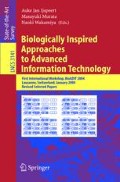Abstract
We describe the response properties of a compact, low power, analog circuit that implements a model of a leaky–Integrate & Fire (I&F) neuron, with spike-frequency adaptation, refractory period and voltage threshold modulation properties. We investigate the statistics of the circuit’s output response by modulating its operating parameters, like refractory period and adaptation level and by changing the statistics of the input current. The results show a clear match with theoretical prediction and neurophysiological data in a given range of the parameter space. This analysis defines the chip’s parameter working range and predicts its behavior in case of integration into large massively parallel very–large–scale–integration (VLSI) networks.
Access this chapter
Tax calculation will be finalised at checkout
Purchases are for personal use only
Preview
Unable to display preview. Download preview PDF.
References
Dayan, P., Abbott, L.F.: Theoretical Neuroscience. The MIT Press, Cambridge (2001)
Chicca, E., Indiveri, G., Douglas, R.: An adaptive silicon synapse. In: Proc. IEEE International Symposium on Circuits and Systems, IEEE, Los Alamitos (2003)
D’Andreagiovanni, M., Dante, V., Del Giudice, P., Mattia, M., Salina, G.: Emergent asynchronous, irregular firing in a deterministic analog VLSI recurrent network. In: Rattay, F. (ed.) Proceedings of the World Congress on Neuroinformatics. ARGESIM Reports, Vienna, pp. 468–477. ARGESIM/ASIM Verlag (2001)
Mead, C.: Analog VLSI and Neural Systems. Addison-Wesley, Reading (1989)
Schultz, S.R., Jabri, M.A.: Analogue VLSI ’integrate-and-fire’ neuron with frequency adaptation. Electronic Letters 31, 1357–1358 (1995)
van Schaik, A.: Building blocks for electronic spiking neural networks. Neural Networks 14, 617–628 (2001)
Boahen, K.: Communicating neuronal ensembles between neuromorphic chips. In: Lande, T.S. (ed.) Neuromorphic Systems Engineering, pp. 229–259. Kluwer Academic, Norwell (1998)
Culurciello, E., Etienne-Cummings, R., Boahen, K.: Arbitrated address-event representation digital image sensor. Electronics Letters 37, 1443–1445 (2001)
Indiveri, G.: Neuromorphic selective attention systems. In: Proc. IEEE International Symposium on Circuits and Systems, IEEE, Los Alamitos (2003)
Liu, S.C., Kramer, J., Indiveri, G., Delbrück, T., Douglas, R.: Analog VLSI:Circuits and Principles. MIT Press, Cambridge (2002)
Ermentrout, B.: Linearization of F-I curves by adaptation. Neural Comput. 10, 1721–1729 (1998)
Liu, Y., Wang, X.: Spike-Frequency Adaptation of a Generalized Leaky Integrate-and-Fire Model Neuron. J. Comput. Neurosc. 10, 25–45 (2001)
Fuhrmann, G., Markram, H., Tsodyks, M.: Spike-Frequency Adaptation and neocortical rhythms. J. Neurophysiology 88, 761–770 (2002)
Rauch, A., Camera, G.L., Luescher, H.R., Senn, W., Fusi, S.: Neocortical pyramidal cells respond as integrate-and-fire neurons to in vivo-like input currents. J. Neurophysiol. 79 (2003)
Wang, X.: Calcium coding and adaptive temporal computation in cortical pyramidal neurons. J. Neurophysiol. 79, 1549–1566 (1998)
Koch, C., Segev, I.: Methods in Neural Modeling, 2nd edn. MIT Press, Cambridge (2001)
Tuckwell, H.: Introduction to Theoretical Neurobiology, vol. 2. Cambridge University Press, Cambridge (1988)
Softky, W., Koch, C.: The highly irregular firing of cortical cells is inconsistent with temporal integration of random EPSPs. J. Neurosci. 13, 334–350 (1993)
Fusi, S., Mattia, M.: Collective behaviour of networks with linear (VLSI) integrate-and-fire neurons. Neural Computation 11, 633–652 (1999)
Ahmed, B., Anderson, J., Douglas, R., Martin, K., Whitteridge, D.: Estimates of the net excitatory currents evoked by visual stimulation of identified neurons in cat visual cortex. Cereb. Cortex 8, 462–476 (1998)
Chicca, E., Badoni, D., Dante, V., D’Andreagiovanni, M., Salina, G., Fusi, S., Del Giudice, P.: A VLSI recurrent network of integrate–and–fire neurons connected by plastic synapses with long term memory. IEEE Trans. Neural Net. 14, 1297–1307 (2003)
Author information
Authors and Affiliations
Editor information
Editors and Affiliations
Rights and permissions
Copyright information
© 2004 Springer-Verlag Berlin Heidelberg
About this paper
Cite this paper
Rubin, D.B.D., Chicca, E., Indiveri, G. (2004). Characterizing the Firing Properties of an Adaptive Analog VLSI Neuron. In: Ijspeert, A.J., Murata, M., Wakamiya, N. (eds) Biologically Inspired Approaches to Advanced Information Technology. BioADIT 2004. Lecture Notes in Computer Science, vol 3141. Springer, Berlin, Heidelberg. https://doi.org/10.1007/978-3-540-27835-1_15
Download citation
DOI: https://doi.org/10.1007/978-3-540-27835-1_15
Publisher Name: Springer, Berlin, Heidelberg
Print ISBN: 978-3-540-23339-8
Online ISBN: 978-3-540-27835-1
eBook Packages: Springer Book Archive

